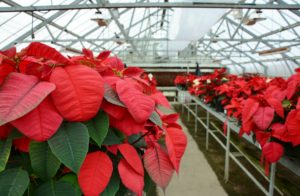Farm & Ranch
[AgriLife Today] Poinsettia trial shows effect of high temperatures on plant growth and flowering

By: Adam Russell
Writer: Adam Russell, 903-834-6191, [email protected]
- Contact: Dr. Brent Pemberton, 903-834-6191, [email protected]
OVERTON – Rows of vivid red poinsettias inside Greenhouse No. 4 at the Texas A&M AgriLife Research and Extension Center in Overton are as eye-catching as a flashing stop light.
Dr. Brent Pemberton, AgriLife Research ornamental horticulturist in Overton, began a trial of more than 30 varieties of the popular holiday flower associated with Christmas to determine how high temperatures affect the growth and flowering of the tropical perennial.
Poinsettias are grown in the fall for sales around the holidays, Pemberton said. The flower naturally sets its buds as days get shorter.
“Sometimes in Texas we can have warmer temperatures in late September and early October when all of this is happening and those high temperatures can have a deleterious effect on floral development and delay crops,” he said. “Producers need to have poinsettias peaking to within a week of a certain date. Typically stores want them before Black Friday, so they’ll ship them before Thanksgiving.”
For that reason, all commercial poinsettias are grown in greenhouses where producers can control temperatures and conditions to have the flowers peak according to contracts with buyers, Pemberton said.
Over the years, varieties have been developed that can tolerate higher temperatures in Texas and the southern U.S., Pemberton said. Trials have been ongoing for several years and there’s interest within the industry to continue research on poinsettias.
“Those breeding efforts continue, so what we are doing here is testing commercial breeding lines to look at the effects of high temperatures,” he said. “The end product will be more heat-tolerant varieties that are good for Texas growers and consumers.”
https://www.youtube.com/watch?v=r8K5vxYHkIc
Pemberton received the plants in early September. The trial placed varieties in separate greenhouses with daily average temperatures of 72 degrees and 82 degrees.
Poinsettias in higher temperatures during floral initiation tend to stretch and do not develop bracts, which provide the color, as quickly or in preferred numbers, Pemberton said.

Most all commercial poinsettias are grown in greenhouses which allows producers to control their growth and when they flower, ensuring they peak for holiday season sales. (Texas A&M AgriLife Extension Service photo by Adam Russell)
Bracts, the recognizable red leafy showcase for the plant, in red varieties, are actually leaves that change physiologically during the natural development of the plant, Pemberton said.
Many plants in the higher temperature greenhouse have yet to flower, he said.
“We treat them with high temperatures for several weeks which would be extreme for production greenhouses but this helps breeders make advances in looking at varieties best suited for Texas growers,” he said.
Under lower average daily temperatures, poinsettias grew to desirable heights, 12-18 inches for plants in 6-inch pots, and bracts were much more numerous and deep vibrant red, Pemberton said.
“They’re a much more desirable plant both from a grower standpoint and for shipping and placement in a retail setting and something that consumers will enjoy more as a decorative plant in their home,” he said.
-30-
Find more stories, photos, videos and audio at http://today.agrilife.org
Farm & Ranch
Hazards of Backyard Poultry

By Barry Whitworth, DVM
Having backyard poultry is a popular agriculture enterprise. According to the United States Department of Agriculture, 0.8 percent of all households in the United States have chickens. People keep chickens for a variety of reasons with table eggs being one of the more common reasons.
Unfortunately, some of these poultry producers are not aware of the hazards that come with keeping poultry because many times they carry pathogens but appear healthy.
Chickens are carriers of several zoonotic diseases. These are diseases that can be passed from animals to humans. According to a recent survey in Pennsylvania, a majority of backyard poultry producers were aware of the dangers of avian influenza. However, this study also revealed that far fewer producers were aware of the risk of possible exposure to Salmonella and Campylobacter.
The lack of knowledge about the hazards of raising poultry likely contributes to the continued issues of Salmonella outbreaks associated with backyard poultry. In 2023, the Centers for Disease Control and Prevention reported 1,072 illnesses of Salmonella linked to backyard poultry, and 272 of those patients required hospitalization. Oklahoma reported 43 individuals with the disease.
To read more, pick up a copy of the April issue of NTFR magazine. To subscribe by mail, call 940-872-5922.
Farm & Ranch
Ag Elsewhere: Wyoming

By Tressa Lawrence
Babies are tucked away in every nook and cranny. Many ranchers across Wyoming have baby animals popping up all over this time of year.
Farm & Ranch
Ag Elsewhere: Montana

By Lindsey Monk
Another load of grain in to keep feeding the calves until the green grass can really start popping.
-

 Country Lifestyles1 year ago
Country Lifestyles1 year agoScott & Stacey Schumacher: A Growth Mindset
-

 Equine7 months ago
Equine7 months agoThe Will to Win
-

 Country Lifestyles7 years ago
Country Lifestyles7 years agoStyle Your Profile – What your style cowboy hat says about you and new trends in 2017
-

 Country Lifestyles4 years ago
Country Lifestyles4 years agoAmber Crawford, Breakaway Roper
-

 HOME7 years ago
HOME7 years agoGrazing North Texas – Wilman Lovegrass
-

 Country Lifestyles7 years ago
Country Lifestyles7 years agoDecember 2016 Profile, Rusty Riddle – The Riddle Way
-

 Country Lifestyles8 years ago
Country Lifestyles8 years agoJune 2016 Profile – The man behind the mic: Bob Tallman
-

 Outdoor9 years ago
Outdoor9 years agoButtercup or Primrose?






